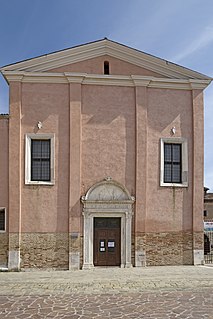
The Oratorio dei Crociferi (Oratory of the Cross Bearers) is a small Roman Catholic prayer hall found across from the church of the Gesuiti in the sestiere of Cannaregio Venice, Italy.

The Oratorio dei Crociferi (Oratory of the Cross Bearers) is a small Roman Catholic prayer hall found across from the church of the Gesuiti in the sestiere of Cannaregio Venice, Italy.
The oratory was part of a convent found by the Order of the Crociferi, a twelfth century order dedicated to ministering to soldiers and pilgrims participating in the crusades or travels to the Holy Land. They had been patronized by Doge Renier Zen, who endowed them with a large inheritance. By the 1300s, it had become a hospital. The complex here had become by the 15th century a hospice for poor women.
The oratory was decorated with eight canvases depicting scenes from the Order of the Crociferi (1583-1592) by Palma il Giovane. The ceiling has a painting on wood of the Assumption of the Virgin with Angelic Musicians. [1] A hospice at the site still remains adjacent to site. Relative to the elaborate Gesuiti facade, the oratory is plain entrance flanked by a house with four tall chimneys. This oratory is owned by the Instituzioni di Ricovero e di Educazione (IRE); entry is by reservation only. The site underwent restoration in 1982-1984.

Antonio da Ponte (1512–1597) was a Venetian architect and engineer, most famous for his rebuilding of the Rialto Bridge in Venice.

Pasquale Cicogna was the Doge of Venice from 1585 to 1595. He supported the claim of Henry of Navarre to the French throne, and convinced Pope Sixtus V to support Henry in exchange for his conversion to Catholicism.
Pasquale is a masculine Italian given name and a surname mainly found in southern Italy. It is a cognate of the French name Pascal, the Spanish Pascual, the Portuguese Pascoal and the Catalan Pasqual. Pasquale derives from the Latin paschalis or pashalis, which means "relating to Easter", from Latin pascha ("Easter"), Greek Πάσχα, Aramaic pasḥā, in turn from the Hebrew פֶּסַח, which means "to be born on, or to be associated with, Passover day". Since the Hebrew holiday Passover coincides closely with the later Christian holiday of Easter, the Latin word came to be used for both occasions.

Iacopo Negretti, best known as Jacopo or Giacomo Palma il Giovane or simply Palma Giovane, was an Italian painter from Venice and a notable exponent of the Venetian school.

The Church of St Job is a 15th-century Roman Catholic church located overlooking the campo of the same name, known as Sant'Agiopo in Venetian dialect, on the south bank of the Cannaregio canal near Ponte dei Tre Archi in the sestiere of Cannaregio of Venice, northern Italy,

Domenico Robusti, also known as Domenico Tintoretto, was an Italian painter from Venice. He grew up under the tutelage of his father, the renowned painter Jacopo Tintoretto.

Marino Grimani was the 89th Doge of Venice, reigning from 26 April 1595 until his death. Grimani's reign as doge was principally remembered for two reasons:

Santa Maria in Trivio is a church in Rome. It is dedicated to Mary, mother of Jesus, and is located on Piazza dei Crociferi in rione Trevi. It is near the Fountain of Trevi.

The Coinage of the Republic of Venice include the coins produced by the Republic of Venice from the late 12th century to 1866. After this date, coins were still produced in Venice.

The church of Santa Maria Assunta, known as I Gesuiti, is a religious building in Venice, northern Italy. It is located in the sestiere of Cannaregio, in Campo dei Gesuiti, not far from the Fondamenta Nuove.

The Oratory of St. Thomas Aquinas is a late-Renaissance-style, Roman Catholic prayer hall located on Via della Pergola in Florence, region of Tuscany, Italy.

The Palazzo Contarini-Sceriman, also called Palazzo Seriman ai Gesuiti is a 14th-century palace in the Sestiere of Cannaregio of Venice, Italy. It is located near the church of the Gesuiti.

Santa Maria di Chiavica is a Renaissance style, former Roman Catholic, now deconsecrated church located on Via S. Maria in Chiavica number 7 in central Verona, region of Veneto, Italy. The building retains portions of its original Romanesque structure and original fresco and altar decoration, but is now used for theatrical and musical performances.

San Francesco di Paola is a Roman Catholic church in Via Garibaldi in the Sestiere of Castello in Venice, Italy.

The ex Jesuits' College is a building in the town centre of Alcamo.

San Bernardino or San Bernardino da Siena is a Baroque-style Roman Catholic church located in vicolo San Bernardino #26 in Rimini, Italy. The church and adjacent convent are now affiliated with Clarissan Order nuns.
San Filippo is a Baroque-style, Roman Catholic church located on Piazza della Repubblica in the town of Treia, province of Macerata, region of Marche, Italy.
San Giovanni Decollato is a Roman Catholic parish church located on Via Memoreto and Via San Pietro in Pistoia, region of Tuscany, Italy. At the other end of Via Memoreto is the Romanesque church of Santa Maria Nuova, and to the left the Oratory of San Desiderio.

The Fontana or Fontanone di Ponte Sisto, once known as the Fontanone dei Cento Preti, is an early 17th-century, monumental fountain now located in Piazza Trilussa, facing the south end of the Ponte Sisto, in Trastevere, Rome, Italy. It was reconstructed here in the late 19th century, originally erected across the river, attached to the former building of the Collegio Ecclesiastico.

Andrea Pisani was a Venetian noble who served as Captain General of the Sea during the Seventh Ottoman–Venetian War.